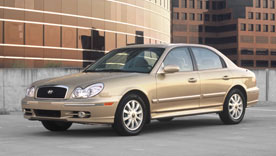The quality surprise
By: Jack Nerad for Driving Today
Date: 2004-09-01
It wasn't too long ago that Korean-built vehicles were thought of as shoddy imitations of the Japanese. After a series of big quality glitches in the early Nineties, Hyundai sales took a steeper plunge than a Magic Mountain roller coaster, and Kias were the butt of Jay Leno's jokes on The Tonight Show. But this year's Initial Quality Study from California-based research firm J.D. Power and Associates indicates the worm is turning. In this study, those once-derided Korean cars out-paced Domestic U.S. brands and, even more surprisingly, the aggregate of European brands. And while the term "paradigm-shift" is perhaps the most-over-used term in the car industry, this turning of the quality tables is a landmark moment.
Korean manufacturers, strongly driven by Hyundai's remarkable improvement, have aggressively cut initial quality problems by 57 percent in the past six years-dropping from 272 problems per 100 vehicles (PP100) in 1998 to just 117 PP100 in 2004. This is a dramatic improvement in the state of initial quality among the Korean-branded vehicles compared to 1998, when they trailed the industry-leading European-branded nameplates by an imposing 116 PP100. The Koreans now lead the Europeans by five PP100 and the Domestics by six PP100, and trail the Japanese by just six PP100.
"A decade ago, as Korean manufacturers struggled with a universally poor reputation for vehicle quality, no one would have predicted they could not only keep pace, but actually pass Domestics and other imports in terms of initial quality," says Joe Ivers, partner and executive director of quality/customer satisfaction at J.D. Power and Associates. "This demonstrates how vastly more competitive the market has become, which is good news for consumers, who will ultimately benefit."
 Even as the Koreans were making historic improvements in quality, there were more widespread initial quality improvements in the automotive industry as well in 2004. The study found initial quality problems dropping 11 percent from 2003. The industry average stands at 119 PP100--the fewest problems since the study was redesigned in 1998.
Even as the Koreans were making historic improvements in quality, there were more widespread initial quality improvements in the automotive industry as well in 2004. The study found initial quality problems dropping 11 percent from 2003. The industry average stands at 119 PP100--the fewest problems since the study was redesigned in 1998.
Although the Korean car makers have zipped past Domestic and Europeans when lumped together, there are still some American and European brands that out-point them in initial quality. On a brand-by-brand basis, Cadillac, Buick, and Mercury are U.S.-based brands that turned in better quality scores than Hyundai, even though the Korean carmaker did finish a surprising seventh in the overall brand rankings. Jaguar was the lone European brand to outdo Hyundai in quality. Meanwhile, the other Korean brand in the U.S. market--Kia--was well below the industry average.
No more pigeon-holing
A key takeaway from the 2004 IQS study is that it is no longer easy to single out high-quality cars by the national origin of their maker. Several Japanese brands--including Subaru, Mitsubishi, Suzuki, Nissan, Mazda, and Scion--scored well below the industry average of 119 problems per 100 vehicles in quality, while a number of domestic brands--including the above-mentioned Cadillac, Buick and Mercury, plus Oldsmobile and Chevrolet, were above industry average.
European brands were all over the board. Mercedes-Benz, Audi, BMW, and Volvo turned in above-average performances, but Saab, MINI, Land Rover, Porsche, and Volkswagen were on the dreary side of the ledger.
IQS measures a broad range of quality problems, heavily weighted toward defects and malfunctions, quality of workmanship, drivability, human factors in engineering (i.e. ease of use) and safety-related problems. The 2004 Initial Quality Study is based on responses from more than 51,000 purchasers and lessees of new 2004 model-year cars and trucks, who were surveyed after 90 days of ownership. This industry benchmark study for new-vehicle initial quality is now in its 18th year.
What about quality after 3 years?
The second J.D. Power and Associates' report, the Vehicle Dependability Study (VDS), measures problem symptoms of three-year-old vehicles, primarily in categories representing malfunctions; noise, vibration and harshness; driveability; dependability; and safety. The VDS report shows that the Koreans still have a long way to go to achieve class-leading dependability. The surprise in this year's VDS was the major progress being made by American manufacturers.
"The domestics are putting their money where their mouths are in terms of consistent long-term quality improvement," says Joe Ivers, partner and executive director of quality/customer satisfaction at J.D. Power and Associates. "However, while the domestics continue to outpace the Europeans in long-term quality, the Japanese continue to dominate."
Mercury (at 224 PP100), Chevrolet (262), GMC (262), and Saturn (267) were American nameplates that ranked above industry average in dependability. The most-improved domestic nameplates included Ford (improving 19 PP100), Lincoln (18), Mercury (16), Dodge (14), Cadillac (13), Plymouth (13), Chevrolet (10) and Chrysler (10). At the bottom of the VDS list as the least-dependable vehicles were Land Rover (472 PP100), Kia (432), Daewoo (411), Isuzu (393), and Volkswagen (386). The most improved brands over their 2003 results were Kia (77 PP100 improvement), Suzuki (38) and Audi (23), although all three were below the industry average.
When it comes to individual models, Toyota and its Lexus sister brand rule the roost in dependability. Toyota Corolla, Toyota Avalon, Toyota MR2 Spyder, Lexus ES 300 and Lexus LS 430 each topped their individual car segments, while the Toyota 4Runner and Lexus RX 300 topped their SUV categories. In high-sales segments, Honda Odyssey was the dependability champ among minivans, Honda CR-V in small SUVs, Ford F-150 in full-size pickups, and Chevrolet Tahoe in the large SUV class.
---Driving Today Managing Editor Jack R. Nerad once served J.D. Power and Associates as Director of Publications.
Comments to this article have been disabled.
